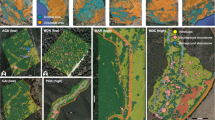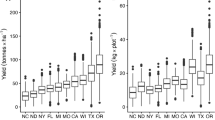Abstract
The forces of divergence in the cultivated populations of crops belonging to different breeding systems,Sorghum, Pennisetum, Brassica, linseed and wheat, have been examined utilising the centroid method of factor analysis. The populations consisted of mostly elite material of high productivity.
Three factors were found to be adequate to account for most of the total communality although upto fourteen variables have been included. The results confirmed that the use of genetic correlation matrices in populations under intensive human selection would change the factor loadings to a considerable degree as compared to environmental correlation matrices.
The factor loadings inSorghum indicated the important role of the reproductive factor and the growth factor in the evolution of this genus. In the case ofPennisetum, ear girth, ear length and height were important in the first factor, while early vigour and flowering time were predominant for the second foctor. InBrassica, the data have also indicated that disruptive selection for flowering time had substantially modified factor loadings in ease of the genotypic correlation matrix and had, therefore, substantially modified the course of evolution. In the case of linseed, the inclusion of F1 hybrids did not change the major conclusions drawn about factor loadings for factors from the genotypic correlation matrix.
The number of factors and the loadings did not appear to be directly related to the breeding system but were found to be influenced by the past history of selection. The first factor which contributed the most to the total communality was concerned with reproductive capacity and characters influencing major components of fitness under both human and natural selection.
Similar content being viewed by others
References
Cattell R. B. (1965). Factor analysis: An introduction to essentials I. The purpose and underlying models.Biometrics 21: 190–215.
Cattell R. B. (1965). Factor analysis: An introduction to essontials II. The role of factor analysis in research.Biometrics 21: 405–435.
Holzinger, K. J. & H. H. Harman (1941). Factor Analysis. University of Chicago Press.
Lawley D. N. & A. E. Maxwell (1963). Factor analysis as a statistical method. Butterworths. London, pp. 117.
Maxwell A. E. (1961). Recent trends in factor analysis.J. Roy. Statis. Soc., A. 124: 49–59.
Morishima H. & H. I. Oka (1960). The pattern of variation in the genusOryza: Its quantitative representation by statistical methods.Evolution 14: 153–165.
Murty B. R. & V. Arunachalam (1966). The nature of divergence in relation to breeding system in some crop plants.Ind. J. Genet. 26: 188–198.
Murty B. R. & V. Arunachalam (1967). Factor analysis of diversity in the genusSorghum.Ind. J. Genet. 27: 123–135.
Rao C. R. (1964). The use and interpretation of principal component analysis in applied research.Sankhya 26A: 329–358.
Seal H. L. (1964). Multivariate statistical analysis for biologists. (Ed. 1). Methuen, London pp. 207.
Author information
Authors and Affiliations
Rights and permissions
About this article
Cite this article
Murty, B.R., Arunachalam, V. & Jain, O.P. Factor analysis in relation to breeding system. Genetica 41, 179–189 (1970). https://doi.org/10.1007/BF00958903
Received:
Issue Date:
DOI: https://doi.org/10.1007/BF00958903




